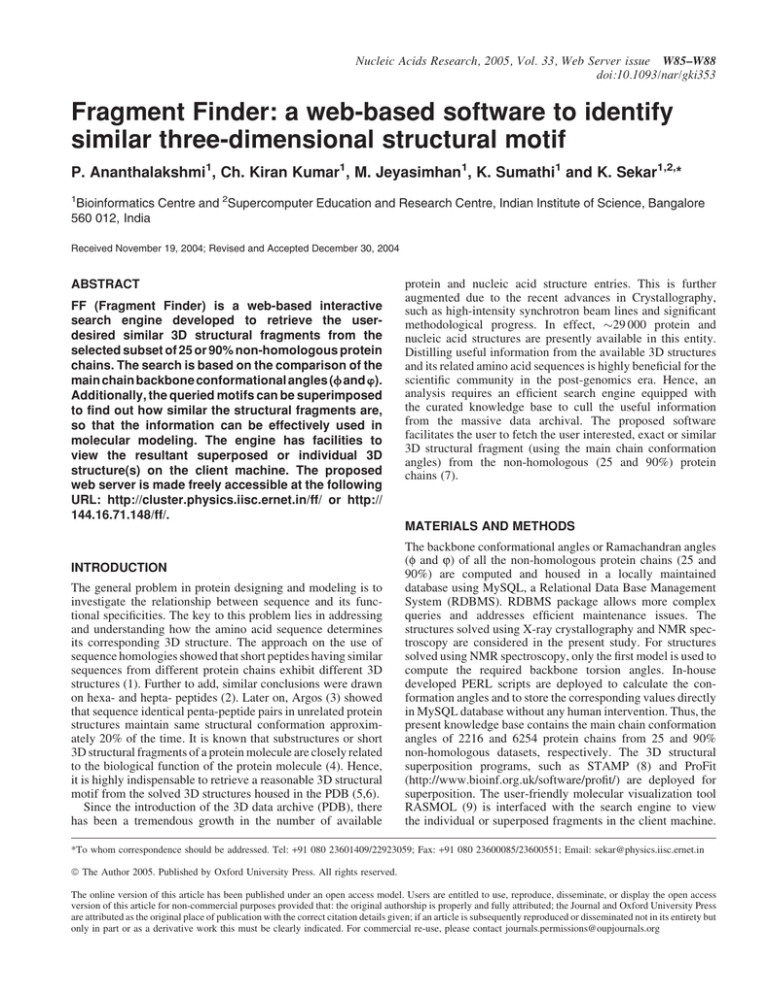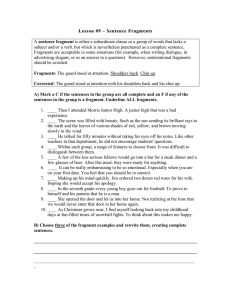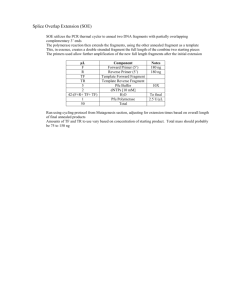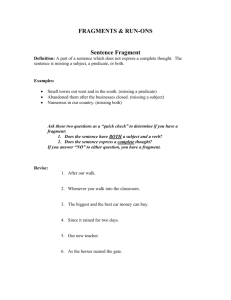
Nucleic Acids Research, 2005, Vol. 33, Web Server issue W85–W88
doi:10.1093/nar/gki353
Fragment Finder: a web-based software to identify
similar three-dimensional structural motif
P. Ananthalakshmi1, Ch. Kiran Kumar1, M. Jeyasimhan1, K. Sumathi1 and K. Sekar1,2,*
1
Bioinformatics Centre and 2Supercomputer Education and Research Centre, Indian Institute of Science, Bangalore
560 012, India
Received November 19, 2004; Revised and Accepted December 30, 2004
ABSTRACT
FF (Fragment Finder) is a web-based interactive
search engine developed to retrieve the userdesired similar 3D structural fragments from the
selected subset of 25 or 90% non-homologous protein
chains. The search is based on the comparison of the
main chain backbone conformational angles (f and w).
Additionally, the queried motifs can be superimposed
to find out how similar the structural fragments are,
so that the information can be effectively used in
molecular modeling. The engine has facilities to
view the resultant superposed or individual 3D
structure(s) on the client machine. The proposed
web server is made freely accessible at the following
URL: http://cluster.physics.iisc.ernet.in/ff/ or http://
144.16.71.148/ff/.
INTRODUCTION
The general problem in protein designing and modeling is to
investigate the relationship between sequence and its functional specificities. The key to this problem lies in addressing
and understanding how the amino acid sequence determines
its corresponding 3D structure. The approach on the use of
sequence homologies showed that short peptides having similar
sequences from different protein chains exhibit different 3D
structures (1). Further to add, similar conclusions were drawn
on hexa- and hepta- peptides (2). Later on, Argos (3) showed
that sequence identical penta-peptide pairs in unrelated protein
structures maintain same structural conformation approximately 20% of the time. It is known that substructures or short
3D structural fragments of a protein molecule are closely related
to the biological function of the protein molecule (4). Hence,
it is highly indispensable to retrieve a reasonable 3D structural
motif from the solved 3D structures housed in the PDB (5,6).
Since the introduction of the 3D data archive (PDB), there
has been a tremendous growth in the number of available
protein and nucleic acid structure entries. This is further
augmented due to the recent advances in Crystallography,
such as high-intensity synchrotron beam lines and significant
methodological progress. In effect, 29 000 protein and
nucleic acid structures are presently available in this entity.
Distilling useful information from the available 3D structures
and its related amino acid sequences is highly beneficial for the
scientific community in the post-genomics era. Hence, an
analysis requires an efficient search engine equipped with
the curated knowledge base to cull the useful information
from the massive data archival. The proposed software
facilitates the user to fetch the user interested, exact or similar
3D structural fragment (using the main chain conformation
angles) from the non-homologous (25 and 90%) protein
chains (7).
MATERIALS AND METHODS
The backbone conformational angles or Ramachandran angles
(f and j) of all the non-homologous protein chains (25 and
90%) are computed and housed in a locally maintained
database using MySQL, a Relational Data Base Management
System (RDBMS). RDBMS package allows more complex
queries and addresses efficient maintenance issues. The
structures solved using X-ray crystallography and NMR spectroscopy are considered in the present study. For structures
solved using NMR spectroscopy, only the first model is used to
compute the required backbone torsion angles. In-house
developed PERL scripts are deployed to calculate the conformation angles and to store the corresponding values directly
in MySQL database without any human intervention. Thus, the
present knowledge base contains the main chain conformation
angles of 2216 and 6254 protein chains from 25 and 90%
non-homologous datasets, respectively. The 3D structural
superposition programs, such as STAMP (8) and ProFit
(http://www.bioinf.org.uk/software/profit/) are deployed for
superposition. The user-friendly molecular visualization tool
RASMOL (9) is interfaced with the search engine to view
the individual or superposed fragments in the client machine.
*To whom correspondence should be addressed. Tel: +91 080 23601409/22923059; Fax: +91 080 23600085/23600551; Email: sekar@physics.iisc.ernet.in
ª The Author 2005. Published by Oxford University Press. All rights reserved.
The online version of this article has been published under an open access model. Users are entitled to use, reproduce, disseminate, or display the open access
version of this article for non-commercial purposes provided that: the original authorship is properly and fully attributed; the Journal and Oxford University Press
are attributed as the original place of publication with the correct citation details given; if an article is subsequently reproduced or disseminated not in its entirety but
only in part or as a derivative work this must be clearly indicated. For commercial re-use, please contact journals.permissions@oupjournals.org
W86
Nucleic Acids Research, 2005, Vol. 33, Web Server issue
In the output display, options are provided for the users to store
the 3D atomic coordinates of the resultant fragments in the
local disk of the client machine. The database related to nonhomologous sequences will be updated as and when it is
available (Hobohm and Sander anonymous FTP server,
Heidelberg, Germany).
FEATURES
The primary goal of this project is to maintain a high quality
knowledge base and an efficient search engine to get the user
interested 3D structural fragments present in the nonhomologous protein chains. We have developed a userfriendly interactive web interface to access the information
in the MySQL database while querying the exact or similar
structural fragments. As of December 2003 release, a total of
2216 polypeptide chains from 2105 protein structures are
available under 25% non-homologous subset and the corresponding numbers in the 90% subset are 6254 and 5602,
respectively. Users can select the input fragment of interest
using three options. For the first option, user needs to provide
the PDB-ID and the complete chain information will be displayed on the resultant output page so that users can select the
fragment of interest. Users need to upload the 3D atomic
coordinates of the fragment (PDB file format) for the second
option. For the third option, the main chain conformation
angles (f and j) of the interested structural fragment are
required and the user needs to provide the same.
Once the query fragment is chosen, the user has several
fine-tuning parameters (described in the subsequent sections)
to control the quality of the output fragments.
(i) The users can opt to pickup the structural fragments with
identical (as given in the input) or similar residues or any
residue pattern as long as the backbone conformation
angles match.
(ii) Users can select a particular experiment (X-ray diffraction
or NMR technique) method so that the appropriate information in the knowledge base will be used during search
process.
(iii) In addition to the experiment method, users can also select
the required non-homologous (25 and 90%) protein chains
on which the search has to be performed.
(iv) There is a provision to select the tolerance level (by default
5 ) on the conformation angles (on either side of f and j).
During validation of this software, we experienced that
5 tolerance level is reasonable for a-helical fragments.
However, >10–15 is required in the case of b-strands.
Users are therefore advised to use the appropriate values
to get the hidden structural fragments.
(v) If the queried structural motif is not present in the
knowledge base, facilities are provided in the search
engine for the users to truncate the residues (by default
one at a time) and repeat the search from the N- or
C-terminal end. This option facilitates the user to have
freedom in selecting the required information.
(vi) Finally, in the output display, user has the freedom to see
either the detailed output (example not shown) or simple
output (see case study for details) of the queried motif and
the resultant motifs from the knowledge base for better
understanding of the agreement.
After completing the above fine-tuning options, the output
page displays the structural fragments that match the input
fragment. Furthermore, options are there to superpose the
fragments displayed in the output page. To facilitate this,
user needs to select the fragments by clicking the radio button
provided against them. To avoid delay in displaying the superposition results, the program is coded in such a way that a
maximum of 20 fragments can be superposed at any given
time. For superposition, two programs, STAMP and ProFit,
are interfaced with the search engine. The program STAMP
looks for overall topological similarity for superposing the
structures, whereas ProFit is based on least squares fit of
proteins. Thus, the user has the option to choose a suitable
program for superposition. The output shows details like rootmean-square (rms) deviations between the fixed and the superposed fragments. Most importantly, the users can view the
superposed fragments using the molecular visualization tool
RASMOL. Additionally, the users can save the atomic
coordinates of the superposed fragments in the local machine
for further analysis. The users can get parameters like rotation
matrix and translation vector applied to the individual mobile
fragments used in the superposition by clicking the option
‘Detailed report’ (see Figure 2 for details). In addition, it
shows the sequence identity and stamp score (only if the
program STAMP is used for superposition). The proposed
search engine allows the users to view the structural
fragments, which has low rms deviations and the deviation
of the individual Ca atoms between the fixed and the mobile
fragments.
CASE STUDY
A sample output of a typical search using a part of a helix
containing eight residues [PDB-ID: 1UNE (10), residues 2–9]
is shown in Figure 1. The top panel of Figure 1 shows the main
chain conformation angles computed using the input structural
fragment stated above. The bottom panel shows the matched
hits available in 25% non-redundant protein chains. The output
page displays the simple output of 13 fragments match with
the input structural motif (using default values provided in the
search engine) from various protein chains available in 25%
non-redundant data set. The top left Rasmol panel of Figure 2
shows the nature and the location of the input fragment (green
colored ribbon) with respect to the entire protein molecule
(backbone trace). The right bottom panel shows the superposed structural fragments of all 13 hits listed in Figure 1.
The first and the second columns of the adjacent panel show
the sequence identity (between the fixed and the corresponding
mobile molecule) and the STAMP score, respectively. The
root mean square deviations of various fragments with respect
to the fixed molecule are listed in the third column. The last
column shows the coloring scheme adopted in the Rasmol
display.
The search engine is written in Perl. To meet the increasing
demand and to drastically improve the efficiency, the search
engine is designed for a high-end processor, Intel based Solaris
operating environment (a 3.06 GHz Pentium IV processor with
1 GB of main memory). The software has been validated and
the response time is very fast. However, the response time
varies depending upon the network speed. The front end of this
Nucleic Acids Research, 2005, Vol. 33, Web Server issue
W87
Figure 1. The top panel of the output page displays the main-chain conformation angles for the input fragment (residues 2–9 from the PDB-ID code 1UNE).
The bottom panel shows the output of the matched structural fragments (only PDB-IDs) found in 25% non-homologous protein chains.
Figure 2. The output page depicts the superposition (top middle panel) of the 13 hits listed at the bottom of Figure 1. The left panel displays the location of the input
fragment (ribbon colored green) with respect to the entire molecule (backbone trace). The right bottom panel displays the superposition (using the program STAMP)
of all the 13 hits found by the search engine. This panel can be invoked by clicking the option ‘Display all the structures’.
W88
Nucleic Acids Research, 2005, Vol. 33, Web Server issue
tool is designed in HTML and JavaScript. The search engine is
very user friendly and can be accessed using Windows 95/98/
2000, Windows NT server, Linux and Silicon Graphics (SGI)
platforms with the NETSCAPE (version 4.7) browser. The
users need to interface the graphics freeware, RASMOL
when they use it for the first time (see the help: how to
configure RASMOL).
and Technology), Government of India. Finally, the authors
thank Dr Geoff Barton and Dr Andrew Martin for permitting
to use their superposition programs STAMP and ProFit,
respectively, in the proposed search engine. The authors
thank Ms P. Mridula for critical reading of the manuscript.
The Open Access publication charges for this article were
waived by Oxford University Press.
Conflict of interest statement. None declared.
CITATION OF FRAGMENT FINDER (FF)
The users of FF are requested to cite this article and the URL of
the search engine in their scientific reports and investigations.
General comments and suggestions for additional options
are welcome and should be addressed to Dr K. Sekar at
sekar@physics.iisc.ernet.in.
CONCLUSIONS
The described search engine is best optimized to identify exact
or similar structural fragments from the non-homologous
protein chains to better support researches that investigate
the relationship between the amino acid sequences and the
3D structures. Hence, we strongly believe that the software
is very useful especially for those practicing in the area of
modern bioinformatics or computational biology.
ACKNOWLEDGEMENTS
The authors gratefully acknowledge the use of the
Bioinformatics Centre; the interactive graphics based molecular modeling facility and the Supercomputer Education and
Research Centre. The development of this software is fully
supported by an individual research grant to Dr K. Sekar
from the Department of Biotechnology (Ministry of Science
REFERENCES
1. Kabsch,W. and Sander,C. (1984) On the use of sequence homologies to
predict protein structure: identical penta-peptides can have completely
different conformations. Proc. Natl Acad. Sci. USA, 81, 1075–1078.
2. Wilson,I.A., Haft,D.H., Getzoff,E.D., Tainer,J.A., Lerner,R.A. and
Brenner,S. (1985) Identical short peptide sequences in unrelated proteins
can have different conformations: A testing ground for theories of
immune recognition. Proc. Natl Acad. Sci. USA, 82, 5255–5259.
3. Argos,P. (1987) Analysis of sequence-similar pentapeptides in unrelated
protein tertiary structures. Strategies for protein folding and a guide for
site-directed mutagenesis. J. Mol. Biol., 197, 331–348.
4. Guo,T., Hua,S., Ji,X. and Sun,Z. (2004) DBsubLoc: database of protein
sub cellular localization. Nucleic Acids Res., 32, D122–D124.
5. Bernstein,F.C., Koetzle,T.F., Williams,G.J.B., Meyer,E.F.,Jr,
Brice,M.D., Rogers,J.R., Kennard,O., Shimanouchi,T. and Tasumi,M.J.
(1977) The Protein Data Bank: a computer based archival file for
macromolecular structures. J. Mol. Biol., 112, 535–542.
6. Berman,H.M., Westbrook,J., Feng,Z., Gilliland,G., Bhat,T.N.,
Weissig,H., Shindyalov,I.N. and Bourne,P.E. (2000) The Protein Data
Bank. Nucleic Acids Res., 28, 235–242.
7. Hobohm,U. and Sander,C. (1994) Enlarged representative set protein
structures. Protein Sci., 3, 522–524.
8. Russell,R.B. and Barton,G.J. (1992) STAMP: multiple protein sequence
alignment from tertiary structure comparison. Proteins, 14, 309–323.
9. Sayle,R.A. and Milner-Whilte,E.J. (1995) RASMOL: Biomolecular
graphics for all. Trends Biochem. Sci., 20, 374–382.
10. Sekar,K. and Sundaralingam,M. (1999) High resolution refinement of the
orthorhombic form of bovine pancreatic phospholipase A2. Acta
Crystallogr. D Biol. Crystallogr., D55, 46–50.


![[#SWF-809] Add support for on bind and on validate](http://s3.studylib.net/store/data/007337359_1-f9f0d6750e6a494ec2c19e8544db36bc-300x300.png)






